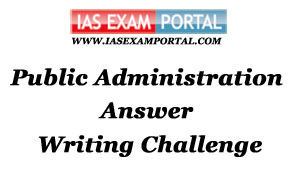Weekly Mains Exam 2016 Answer Writing Challenge - Public Administration "MODULE- 44"

Weekly Mains Exam 2016 Answer Writing Challenge- Public Administration
The main idea behind Weekly Answer Writing Challenges is to make your exam preparation more result oriented. For this exam (UPSC Civil Services), just ‘reading’ is not enough. The most advantageous part of this writing exercise is to make your answer visible to everyone, someone may correct you if they find a mistake in your answer plus it must be also supported by our experts , you may see others answers also. It is free and definitely will improve your writing ability and marks in your final examination. Here all topics from syllabus will be covered.
Public Administration- Paper I "Syllabus Topic – Accountability and control : Citizen Charter"
-
Q1. " Citizen Charter is for ensuring high standards and timely delivery of Public Services." Discuss
Model Answer :
The Citizen’s Charter has its genesis in United Kingdom 1991, with an aim to make the administration more citizen centric and to reduce the widening trust deficit. In India it was adopted in 1997 aiming at continuously improving the quality of services so that services respond to the needs of the people.
It ensures the Rights of the public and the obligations of the Public Servants.
The components of the Indian Citizen's Charter includes
a) The range of services that an organization makes available to its
different categories of clients
b) The standards of services or commitments with respect to quality of services
c) Time frame within which each category of services would be offered
d) Grievance redressal mechanisms and means to access it
e) Expectations from the Client
It design serves as a tool that ensures greater consultation with the clients and other stakeholders (cutting edge officers) in the formulation of the citizen’s charter so that there are realistic expectations both from the client and the service provider. Its mechanism of grievance redressal also empowers the clients to ensure timely delivery. However, challenges have been found in its effective implementation.
If successfully implemented, the Charter can enable the following:
a) Improved service delivery;
b) Greater responsiveness of officials towards the public: and
c) Greater public satisfaction with services.
The Department of Administrative Reforms and Public Grievances conducted an independent evaluation in 2002-2003 which highlighted that the Charter’s were not being designed with adequate consultation. There was low level of awareness among the citizens and the administrative professionals lacked the same vision which the charter aimed to fulfill. It was hence observed that despite its high ideals, the charter had not been successful in achieved high standards of public services and accountability.
To uphold the ideals of citizen centricity and to strengthen the Citizen’s Charter, the ARC II has recommeded a 7 step model :
a) Define all services that you provide and identify your clients
b) Set standards and norms for each service
c) Develop capability to meet the standards
d) Perform to achieve the standards
e) Monitor performance against set standards
f) Evaluate impact through an independent mechanism
g) Ensure continuous improvement based on monitoring and evaluation
It is meant to be a toolkit of initiatives and ideas to raise the level of standards and service delivery and increase public participation, in the most appropriate way. The Charter should be an effective tool to ensure transparency and accountability and should help deliver good governance if implemented vigorously by the government departments.
Indian Administration- Paper II "Syllabus Topic – Public Sector Undertakings: Public sector in modern India"
- Q2. Discuss the nature and role of advisory bodies in governance with citing examples from Indian Administration.
